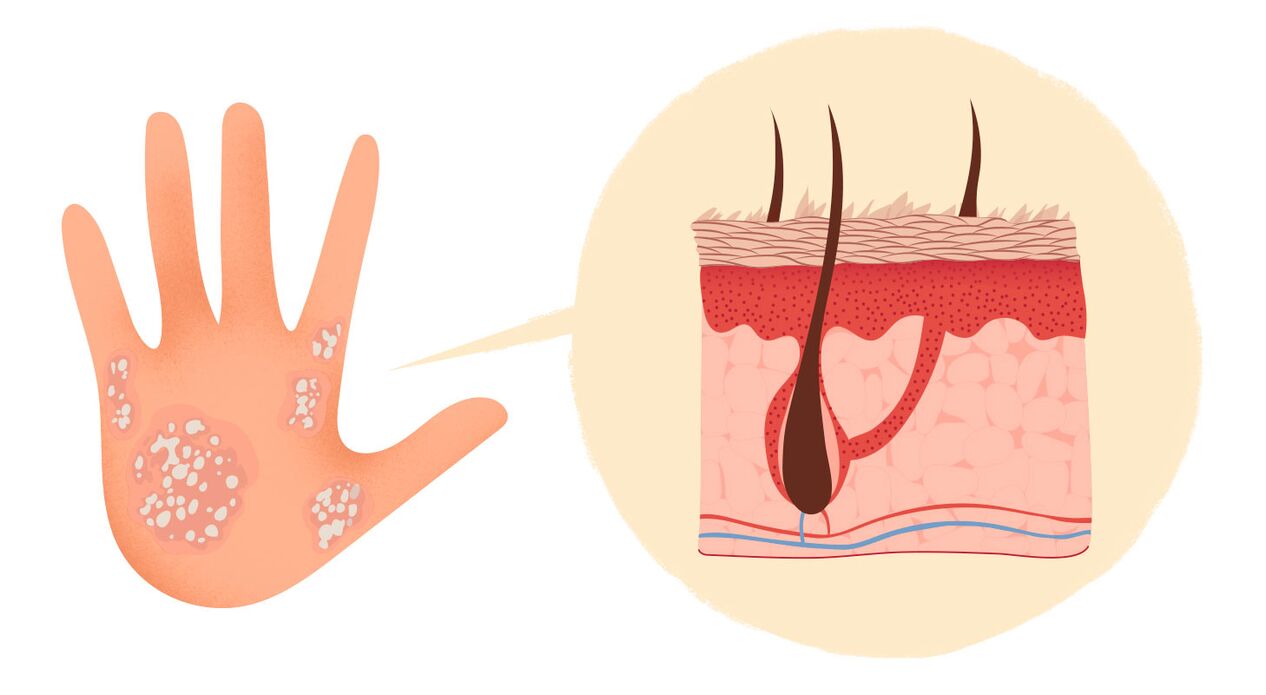
The most common symptom of psoriasis is the formation of psoriasis plaques that form on the inflamed areas of the skin. However, the disease can not only manifest itself on the skin. We understand how psoriasis begins, how it occurs, and what the signs of psoriasis are.
Most often, the first symptoms of psoriasis appear at a young age, but psoriasis can catch up in old age. The first symptoms of psoriasis can be subtle: the disease can start with changes in small areas of the skin, often in the folds of the limbs or scalp. Therefore, many patients do not notice the first manifestations. Does psoriasis itch the skin? Indeed, one of the signs of psoriasis is itching. Moreover, at first a person can only feel itching and tightness, and only then do red spots begin to appear on the skin.
The course of psoriasis greatly affects the quality of human life. Many patients experience not only physical but also psychological discomfort. However, modern medicine can effectively curb the manifestations of the disease. New anti-psoriasis drugs developed in the 21st century, especially genetically modified biological drugs (GIBPs), allow for the complete elimination of the manifestations of the disease and a productive lifestyle.
What is psoriatic plaque?
Psoriatic plaques are the most common symptom of psoriasis. Plaques are enlarged, inflamed areas of red skin that rise above the surface of healthy skin and are covered with a layer of whitish scales. Plaque can be painful, itchy, cracked and bleeding.

Psoriasis. Signs
Manifestations of psoriasis on the skin and nails
Skin
- Inflamed plaques with redness.
- Plaques are often covered with whitish scales.
- Plaques can be painful and itchy.
- Sometimes they crack and bleed.
- Scattered plaques may appear on the scalp.
- Plaques can grow and fuse together and cover a large area of skin. In severe cases, the entire skin is a single large plaque. This condition is called erythroderma.
Nails
- Nails change color or dents, dots, or streaks appear on the nail plates.
- Over time, the nails will thicken and turn gray, yellow or brown. It may collapse and bleed.
- The nail may become scaly and peeled. Under such torn nails, the skin thickens as psoriasis plaque forms here.

The most common symptoms of psoriasis
Itching and bleeding with psoriasis
Itching and burning of the skin are common symptoms of psoriasis, affecting 90% of patients. Itching caused by psoriasis is different from itching caused by other skin conditions. Itching in psoriasis can be very severe and may even occur in areas of the skin where there are no visible plaques. Scabies due to itching in psoriasis can cause new rashes due to mechanical damage to the skin.
Appearance of cracks on the skin and bleeding with psoriasis
Psoriatic plaques can appear anywhere on the skin. Sometimes they crack because the skin dries a lot on the plaque. As the plaque grows, the cracks expand. As they grow, they can get deeper into the dermis - the layer of skin that contains the capillaries. The capillaries are then damaged and explode and the plaques begin to bleed.
The first symptoms of psoriasis can occur anywhere, but more often the skin starts to crack and bleed. Place of manifestations:
- elbows;
- knee;
- brushes;
- palms and soles.
Pustules with psoriasis
The main symptom of pustular psoriasis is pustules with white or yellowish fluid appearing on psoriatic plaques. This is a rare form of psoriasis and only 2% of patients develop pustules. Pustular psoriasis is a very dangerous condition. It can cause serious complications and therefore requires urgent complex treatment and a referral to a specialist.
How do pustules form? How does pustular psoriasis start?
- First, pustular psoriasis forms plaques that are formed by dry, reddened skin that is painfully affected.
- Pustules full of pus then form on the plaques.
- The pustules fuse together quickly to form large blisters.
- They then dry out and peel off, leaving dry skin beneath them, on which they may soon reappear.
Teardrop plaques for psoriasis
Small reddish or pink scaly lumps - patches of skin that look like drops - are a symptom that distinguishes tearful psoriasis. The patient may experience hundreds of teardrop-shaped elements. Lumps occur anywhere on the skin, but most commonly occur in:
- shoulders;
- stomach;
- back;
- hands;
- legs;
- scalp;
- ears;
- face.
Symptoms of guttate psoriasis develop fairly quickly over several days. Sometimes teardrop-shaped plaques cause itching in psoriasis. Such elements are usually small and do not exceed 10 mm in width.
Tearful psoriasis often flares up after an infection, especially in the airways.
Pains with psoriasis
Pain in the projection of the rash occurs when the skin is damaged and ruptured due to inflammation and excessive thickening caused by proliferative growth of keratinocytes. As a result, nerve endings in the dermis become irritated and send a signal of pain to the brain.
But pain isn’t just caused by mechanical damage to the skin: inflammation in the body in psoriasis affects how the brain perceives pain. Moreover, each person has an individual pain sensitivity threshold, so pain in patients with the same picture of the disease may elicit a different response.
42% of patients complain of pain in the projection of psoriasis lesions. To a greater extent, this symptom is common in:
- women;
- elderly people;
- patients with severe psoriasis;
- patients with psoriasis for a long time;
- patients with concomitant psoriasis.
Peeling with psoriasis
Psoriasis plaques on the scalp are hidden and may not be visible. However, as in other areas of the body, psoriatic plaques peel off and form dandruff-like scales. Do not confuse psoriasis peeling with bran, as dandruff is caused by a fungal infection and psoriasis is caused by inflammation. Therefore, these symptoms should be treated differently.
Like other symptoms of psoriasis, exfoliation occurs during exacerbation and disappears during remission. Exacerbation of scalp psoriasis occurs for a variety of reasons:
- cold weather;
- dry air;
- tension.
Write a review of what to do if you have psoriasis psoriasis psoriasis psoriasis psoriasis and inflammation
Changes in the nails with psoriasis
- Half of the patients with psoriasis develop nail psoriasis, and 80% of the patients with psoriatic arthritis develop this symptom. In general, the defeat of the nail plates prevents the development of psoriatic arthritis.
- Typically, nail psoriasis is associated with other types of psoriasis on the skin. Only 5-10% of patients with nail psoriasis have no skin lesions.
- Psoriasis of the nails occurs in different patients, regardless of age, gender, and duration of the disease.
- The changes may affect all or part of the nail plate. They appear on one or more nail plates and more often on the hands.
- Psoriasis of the nails is usually associated with common (vulgar) psoriasis and arthritis associated with psoriasis.
- Psoriasis affects the condition of the nails in different ways. They can grow or thicken faster. The nail plate often turns white, yellow or brown.
- Thimble-like depressions and streaks appear on the nail.
- As the psoriatic process progresses, the nail begins to deteriorate and eventually is rejected, losing contact with the nail bed.
- Damage to the nail causes unpleasant and painful feelings that significantly reduce the quality of life.























